This doesn’t really have anything to do with native plants, but it does have a lot to do with how we use our land. So I thought you might be interested to have a look at it.

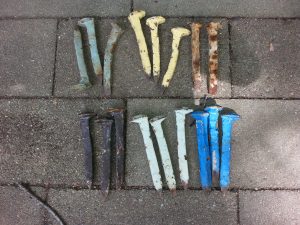
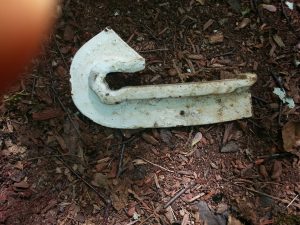
On the left are the five sets of different colours of spikes as well as two extras in case someone loses one, which happens often when we play at dusk. We use the spikes to throw at the “clips”. On the right is what we call a “clip”. It is actually a rail anchor. It is designed to eliminate creepage of track, providing a large bearing surface against the base and tie.
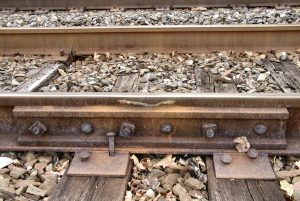
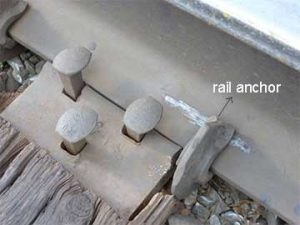
Here you see how the spikes were used. They are actually called dog spikes and there is more info on them here. Here you see the rail base, dog spikes and a rail anchor. There is more info on rail anchors here.
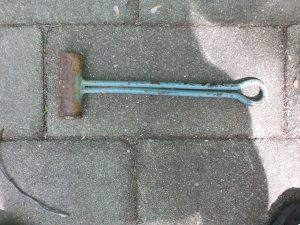
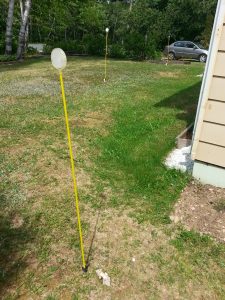 This is an antique hammer that I found somewhere on our lot. We use it to drive the clips into the ground, which I can tell you is not all that easy to do. This is a flag (snow marker which is not being used in the summer). We’re putting in an order to Carole to sew some flags.
This is an antique hammer that I found somewhere on our lot. We use it to drive the clips into the ground, which I can tell you is not all that easy to do. This is a flag (snow marker which is not being used in the summer). We’re putting in an order to Carole to sew some flags.
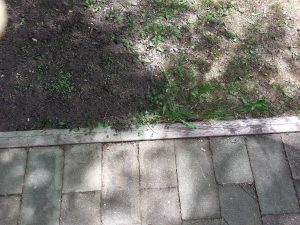
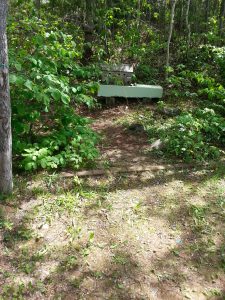 On the left is the first “tee”. Please don’t step on the red clover. We will see if we can use it as a ground cover instead of grass.
On the left is the first “tee”. Please don’t step on the red clover. We will see if we can use it as a ground cover instead of grass.
On the right is the first “hole”, or clip. If you bounce off the birdhouse or the Stonehenge, (concrete bench), onto the clip, the score still counts.

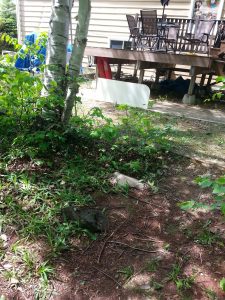
This is the second tee. Please watch out for the fern.
This is the second clip, with the tenth clip in the background.
Notice the piece of melamine instead of a flag as the groundskeepers want to protect the patio.
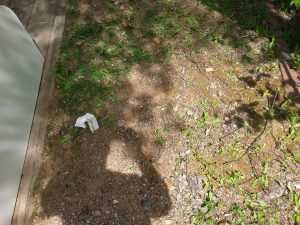 This is the third tee. You can put the scorecard and your pen (or pencil) on the deck, which is right beside it.
This is the third tee. You can put the scorecard and your pen (or pencil) on the deck, which is right beside it.
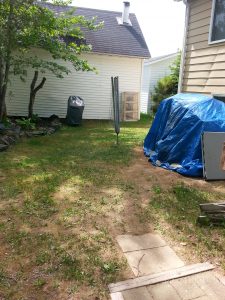 This is the third clip. The umbrella clothesline serves as a flag, which is good because we were short one.
This is the third clip. The umbrella clothesline serves as a flag, which is good because we were short one.
This is the fourth tee. Put your scorecard on Gabriel’s ATV.
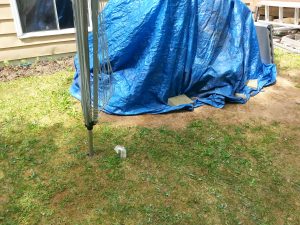 This is the fourth clip. Try not to throw your clip under the tree as it scratches.
This is the fourth clip. Try not to throw your clip under the tree as it scratches.
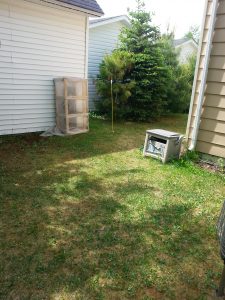 Here is the fifth tee. You can rest your scorecard on Paul’s tree or use the hose box.
Here is the fifth tee. You can rest your scorecard on Paul’s tree or use the hose box.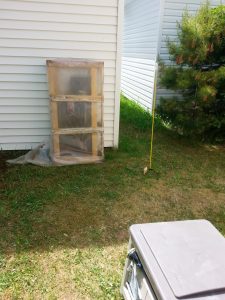
This is the fifth clip and a par 4. Watch out for the tomatoes, yellow beans, sunflowers, cucumbers and chives.
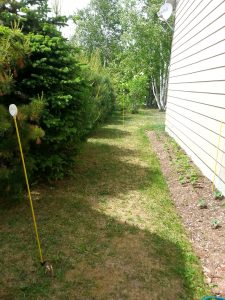 Here is the sixth tee. You can throw from either side, but that tree is scratchy too.
Here is the sixth tee. You can throw from either side, but that tree is scratchy too.
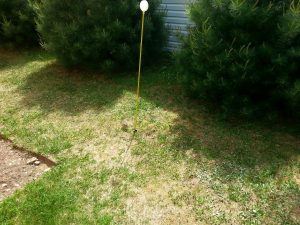 The sixth clip is remarkably free of hazards.
The sixth clip is remarkably free of hazards.

The seventh tee is remarkably void of anywhere to put your scorecard.
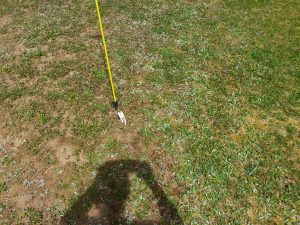 Here on the seventh clip, please do not hit the Virginia roses I just transplanted.
Here on the seventh clip, please do not hit the Virginia roses I just transplanted.
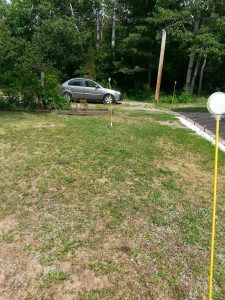 The eighth tee is pretty boring.
The eighth tee is pretty boring.
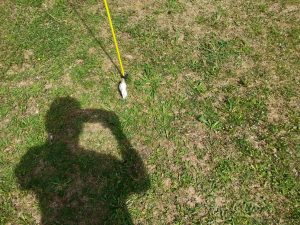
If you haven’t been playing very well, the eighth clip would be about the time to move the car.
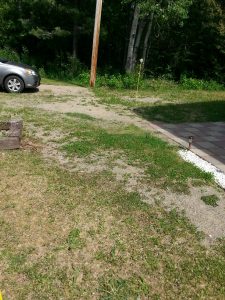 The eighth clip, also the ninth tee, was the hardest to drive.
The eighth clip, also the ninth tee, was the hardest to drive.
 The ninth clip incorporates other sundry parts that were gathered when the clips (rail anchors) and spikes (dog spikes) were gathered.
The ninth clip incorporates other sundry parts that were gathered when the clips (rail anchors) and spikes (dog spikes) were gathered.

The Back Nine
For the back nine, I didn’t have any more parts from what we had found on the tracks. So I had to actually part with some cold hard cash to acquire some rail anchors, or “clips”, to make a full 18 “holes” of Spike Driver Spike Toss. After explaining that I wasn’t actually building a railroad, I was able to get another nine anchors for about $100. Which is a lot of money to spend on a crazy game, but we’ll see how many rounds we get in over the next few years.

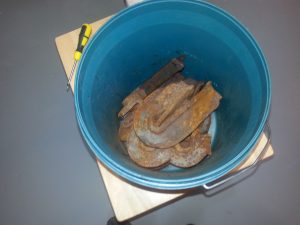
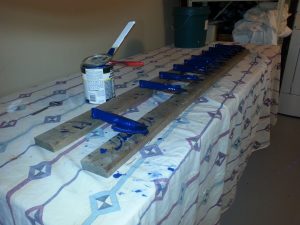
I painted them blue because I wanted them to look different from the front nine, and because I had a big can of blue metal paint left over from some job I can’t remember.
This is the tenth “hole”, or clip.
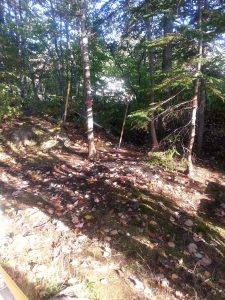
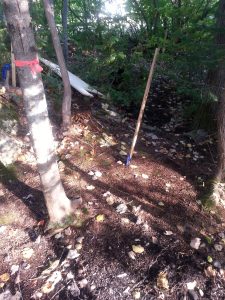

This is the 11th clip. We had some segments of fence
left over that we put or the spikes would get hopelessly lost.
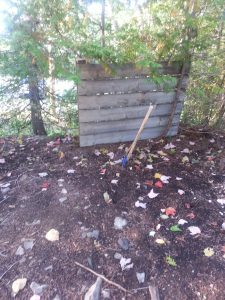
Here is the 12th clip. We used a large log that had a thick branch sticking up. We rest the clip on the branch. We could attach the clip somehow but we think it’s funnier to have to put it back every time someone hits it or hits the log. 
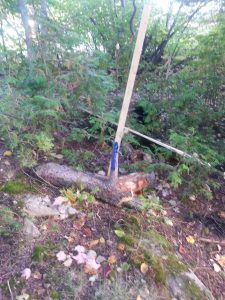
The 13th clip. There is broken glass everywhere on this part of our lot from some former
godforsaken owners, so if you pick some up and put it in the garbage bin, your round is free.
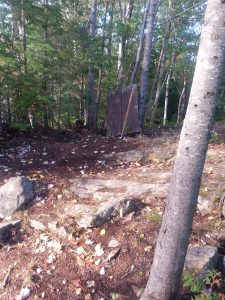
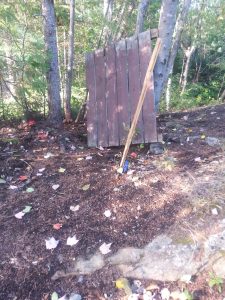
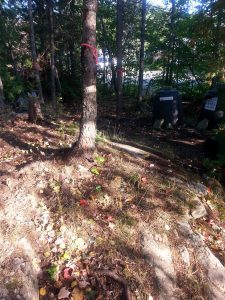
The 14th clip.Thankfully, the compost doesn’t smell.
The tree has a ribbon on it because it is slated to be cut down.
After it has been cut, we will put the clip and the stick in the stump of the cut tree.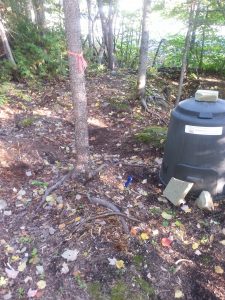
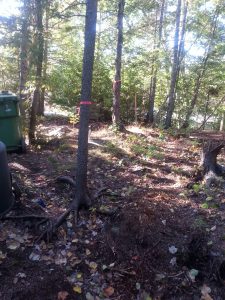
The 15th clip – This is another tree that will be cut and have the clip and stick put in its stump.
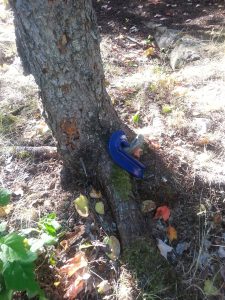
The 16th clip – this “hole” is downhill as the “tee” is about six feet higher than the clip.
I’m thinkin’ I will put this clip in the stump as well, if for nothing else than practise for the other two.
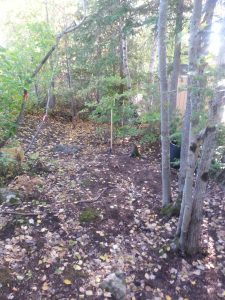
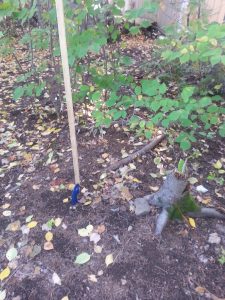
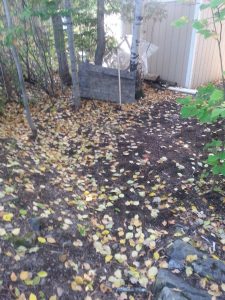
The tee for the 17th clip is crowded by some more trees that
should be gone soon if the landscaper ever shows up.

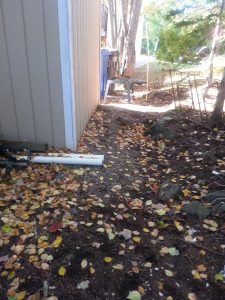
The 18th clip brings us back to the house by way of the
back of the shed. This clip also rests on a stump and
I didn’t have to fasten it, but I really wanted to tie one on.
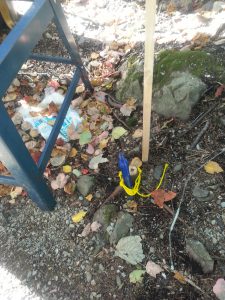
The 19th hole is the deck, and if you want to stay late, we do have patio lanterns.
Preliminary results are that with the underbrush and the limited lighting in the treed area of the back nine, the spikes are just too hard to find after having been thrown. So we have changed the colour scheme for the spikes and painted all of them white with different colours only on the heads. I will let you know how this approach works out.
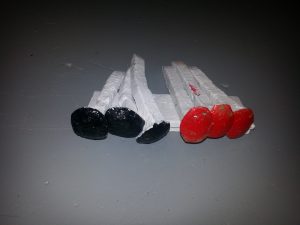
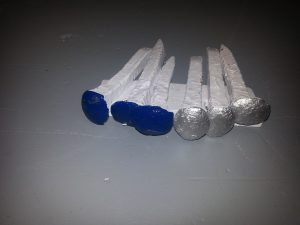
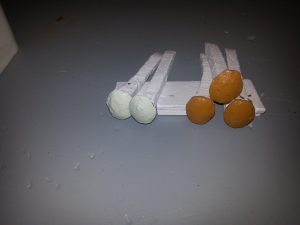
Spike Driver Spike Toss Rules
Each player has three throws at the clip, which has been driven into the ground with an antique hammer
If the player hits the clip with his or her first throw, he or she scores 1
If the player misses with his or her first throw, but hits the clip with his or her second throw, he or she scores 2
If the player misses both his or her first two throws but hits with the third, he or she scores 3
If the player misses on all three throws, he or she scores a 5 on a par 5 or a 4 on a par 4
A par 5 is when the clip is 8 paces away
A par 4 is when the clip is 10 paces away
If a previous player has left a spike close to the clip and a player manages to hit that spike into the clip, that player scores -1
If a player can get all 3 of his or her spikes to land planted in the ground, he or she scores 0
There are posts for flags directly behind the clips – if a player hits the post 3 times, he or she scores 1
If a spike is planted, it can be scored on like a clip
| Barclay Links | Date: | |||||||||
| Distance | 8 | 8 | 10 | 8 | 10 | 8 | 10 | 8 | 10 | TOTAL |
| Par | 5 | 5 | 4 | 5 | 4 | 5 | 4 | 5 | 4 | 41 |
| NAME | 1 | 2 | 3 | 4 | 5 | 6 | 7 | 8 | 9 | |
| Barclay Links | Date: | ||||||||||||||||||||
| Distance | 8 | 8 | 10 | 8 | 10 | 8 | 10 | 8 | 10 | FRONT | 8 | 8 | 10 | 8 | 10 | 8 | 10 | 8 | 10 | BACK | TOTAL |
| Par | 5 | 5 | 4 | 5 | 4 | 5 | 4 | 5 | 4 | 41 | 5 | 5 | 4 | 5 | 4 | 5 | 4 | 5 | 4 | 41 | 82 |
| NAME | 1 | 2 | 3 | 4 | 5 | 6 | 7 | 8 | 9 | 10 | 11 | 12 | 13 | 14 | 15 | 16 | 17 | 18 | |||
june 2007
It’s around 3 am Friday June 15th (2007) and i can’t sleep, so I thought I would take this opportunity to sit at my computer and set down the rules to a game i made up with Sebastien and Gabriel recently – the game is called spike driver spike toss and as I describe to you how the game is played and the things that are used to play it, perhaps it will become apparent why we chose that name.
The genesis of the game was when I took a stroll last year with Gabriel to a neighbor’s, Jocelyn. Gabriel had been working odd jobs for her (for pay) and found her to be a bit of an odd character. He wanted me to meet her and get my opinion of her.
She lives on the other side of the railroad tracks and we had to walk a short ways along them to reach her house. The meeting was uneventful and I found Jocelyn to be quite a nice woman. But on the way home I noticed again around the tracks that there must have been some work going on recently – perhaps they had been rebuilding the roadway where her driveway passed over the tracks. Whatever, the area was riddled with loose spikes and various railroad track parts.
We went home and got some buckets and went back and filled them up with whatever wasn’t fastened down. We had no idea what we would do with them but we figured we would think up something to do with them eventually.
Last summer we made up a game similar to horseshoes where we threw spikes at clips we had driven into the ground at about 8 to 10 paces apart. A clip looks like a letter J and it is the part that is driven into the gravel bed to hold the rail down.
We played the game a few times but it was already late in the summer and we didn’t get in many games.When the good weather finally returned this year we got our bucket of railroad track parts out again and started playing the game again. When I did an inventory of all the parts we had, I realized we had enough clips to set up more than two things to throw at and enough spikes that a foursome could have three each. And, being a multimedia guy who loves to mish-mash things together, I wondered: why not incorporate other sports, especially golf, into our game. So, we set up a course around our house. There are nine holes (so far). I will try to keep the rest of the rules as concise as possible:
(Please see the rules above)
The boys think I’m onto something and I should market this somehow. I keep telling them it’s just like all the things I dream up – something anyone could do if they go for a walk on the tracks. What they don’t seem to realize is that the game has already been successful for me beyond my wildest dreams. They are coming to me and asking me to play the game. They are getting involved. They are turning off the computer and the TV and going outside in the good weather. And they are playing with me. I might not be able to afford the greens fees at Gowan Brae – they would never get golf anyway – but I can always enjoy a game of spike driver’s spike toss golf.
So just let me know if you’d like to reserve a tee-off time. Let me know what color you want your spikes and I’ll fix up a set for you.
Your faithful observer
Bob the Groundskeeper